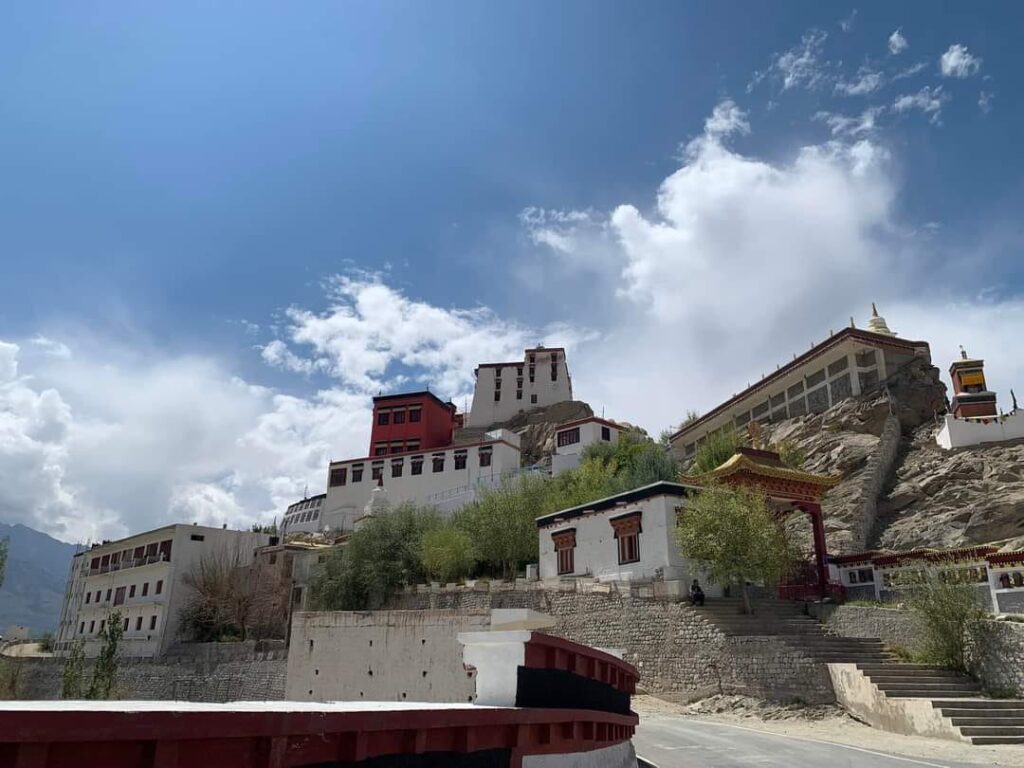
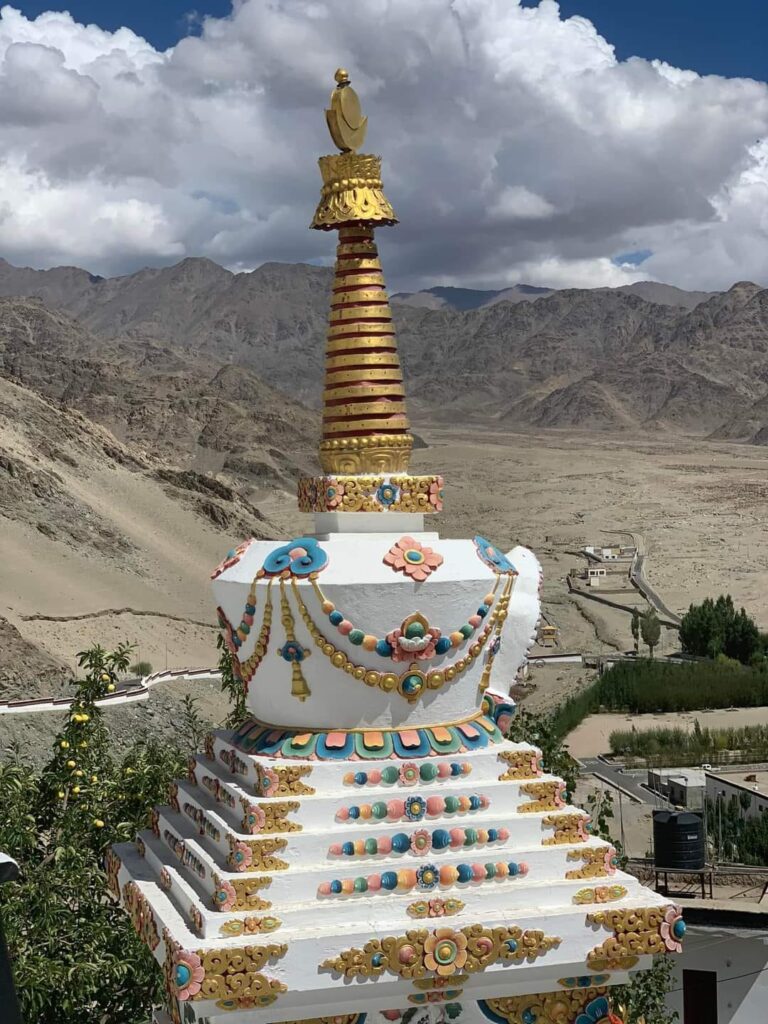
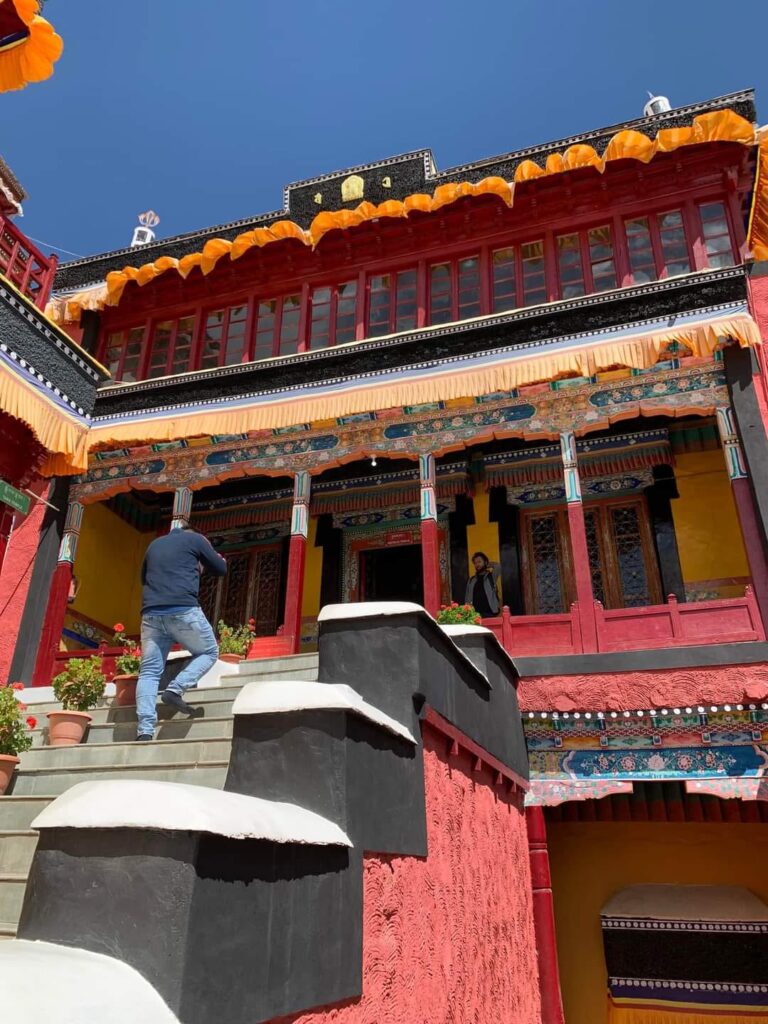
Thiksey Monastery
Thiksey Monastery is a magnificent sight to behold , Located in the heart of Ladakh, India. With its towering whitewashed walls and golden arched roof, it is one of the largest and most important monasteries in the region.
Thiksey is also known as the “Mini Potala” for its striking resemblance to the Potala Palace, the former winter residence of the Dalai Lama in Tibet. The monastery is home to over 500 monks and is a major center of Tibetan Buddhist learning and culture.
Visitors to Thiksey Monastery can explore its many temples and shrines, which are adorned with exquisite murals, statues, and thangkas (Tibetan scroll paintings). The monastery is also home to a 15-meter-tall statue of the Maitreya Buddha, the future Buddha.
One of the best times to visit Thiksey Monastery is during the annual Gustor Festival, which is held in October or November. This vibrant festival features masked dances, music, and chanting, and is a truly unique cultural experience.
Imagine a giant white cake with golden frosting, perched on a mountaintop overlooking a lush green valley. That’s Thiksey Monastery, one of the most important and beautiful Buddhist monasteries in Ladakh.
Thiksey is home to over 500 monks, who study and practice Tibetan Buddhism. The monastery is also a popular tourist destination, known for its stunning architecture, elaborate murals, and ancient artifacts.
Visitors to Thiksey can explore the many temples and shrines, which are dedicated to different Buddhist deities. The monastery is also home to a giant statue of the Maitreya Buddha, the future Buddha.
One of the best times to visit Thiksey is during the annual Gustor Festival, which is held in October or November. This festival features masked dances, music, and chanting, and is a truly unforgettable experience.
Whether you’re a religious pilgrim or simply a curious traveler, Thiksey Monastery is a must-see destination. It’s a place where you can learn about Tibetan Buddhism, admire stunning architecture, and experience the unique culture of Ladakh.
Location of of Thiksey Monastery
Thiksey Monastery is located in Thiksey village, about 19 kilometers (12 miles) east of Leh, the capital of Ladakh, India. It is situated on top of a hill overlooking the Indus Valley.
To get to Thiksey Monastery from Leh, you can take a taxi or shared jeep. The journey takes about 30 minutes. You can also walk to the monastery, but it is a steep uphill walk and takes about an hour.
Once you arrive at the monastery, you will need to purchase a ticket to enter. The ticket includes a guided tour of the monastery.
Thiksey Monastery is open to visitors from 7:00 AM to 6:00 PM, seven days a week. The best time to visit is during the morning or afternoon, when the weather is mild.
The history and background of Thiksey Monastery
First, it is one of the oldest and most important monasteries in the Gelugpa school of Tibetan Buddhism, which is the largest and most influential school of Tibetan Buddhism today. The Gelugpa school was founded by Tsongkhapa in the 14th century, and Thiksey Monastery was established by one of Tsongkhapa’s disciples in the 15th century.
Second, Thiksey Monastery has played a significant role in the spread of Tibetan Buddhism to Ladakh and other parts of the Himalayas. The monastery has been a center of learning and scholarship for centuries, and its monks have traveled widely to teach and spread the Dharma.
Third, Thiksey Monastery has a unique architectural style. The monastery is built on a hilltop and is surrounded by a massive fortification wall. The main temple complex is a 12 story building that is painted in white, red, and ochre colors. The monastery’s resemblance to the Potala Palace in Tibet has earned it the nickname “Mini Potala.”
Architectural Details of Thiksey Monastery
Thiksey Monastery is a marvel of Tibetan Buddhist architecture, with its towering whitewashed walls, golden domes, and intricate detailing. Here are some of the unique architectural features of the monastery:
Multi-tiered structure: The monastery is built on a hillside and rises up in a series of twelve tiers, resembling a giant staircase. This multi-tiered structure is a common feature of Tibetan Buddhist monasteries and symbolizes the path to enlightenment.
Vibrant colors: The monastery’s whitewashed walls are contrasted with bright red and gold accents, creating a visually stunning effect. These colors are symbolic in Tibetan Buddhism, with white representing purity, red representing compassion, and gold representing enlightenment.
Intricate detailing: The monastery’s architecture is adorned with intricate carvings, sculptures, and murals. These details depict Buddhist deities, symbols, and scenes from Buddhist mythology.
Some of the specific architectural details that make Thiksey Monastery unique include:
The Maitreya Buddha statue: The monastery is home to a 15-meter-tall statue of the Maitreya Buddha, the future Buddha. This statue is one of the largest and most impressive representations of the Maitreya Buddha in the world.
The Dukhang: The Dukhang is the main assembly hall of the monastery. It is a large, two-story hall with a soaring ceiling and ornate pillars. The Dukhang is home to a number of important Buddhist relics, including a statue of the Buddha Shakyamuni and a large thangka (Tibetan scroll painting) depicting the Wheel of Life.
The Tsomoling: The Tsomoling is the monastery’s kitchen. It is a large, airy hall with a central hearth and a number of large cauldrons. The Tsomoling is responsible for feeding the monastery’s hundreds of monks, as well as pilgrims and visitors.
The Retreat Center: The Retreat Center is a series of small, secluded rooms where monks go to retreat from the world and focus on their meditation practice. The Retreat Center is located on the topmost tier of the monastery, offering stunning views of the surrounding countryside.
Thiksey Monastery is a truly unique and awe-inspiring place. Its architecture is a testament to the richness and diversity of Tibetan Buddhist culture.
Religious Significance of Thiksey Monastery
Thiksey Monastery is one of the most important Gelugpa monasteries in Ladakh, and its religious significance is manifold.
A Center of Buddhist Learning and Culture: Thiksey is home to a large number of monks, who study and practice all aspects of Tibetan Buddhism. The monastery also has a renowned Buddhist library, which contains a vast collection of scriptures, commentaries, and other texts.
A Seat of Reincarnate Lamas: Thiksey is the seat of several reincarnate lamas, including the Thiksey Rinpoche and the Kyabgon Rinpoche. These lamas are highly respected teachers and leaders in the Gelugpa tradition.
A Site of Pilgrimage: Thiksey is a popular pilgrimage site for Buddhists from all over the world. Visitors come to the monastery to pray, meditate, and learn more about Tibetan Buddhism.
A Symbol of Buddhist Harmony: Thiksey Monastery is a place where different Buddhist traditions coexist peacefully. The monastery is home to monks from different regions of Ladakh, as well as from other parts of India and the world.
The Maitreya Buddha Statue: Thiksey is home to a 15-meter-tall statue of the Maitreya Buddha, the future Buddha. This statue is one of the largest of its kind in the world, and it is a major pilgrimage site for Buddhists who come to pray for the Maitreya Buddha’s arrival.
The Gustor Festival: Thiksey Monastery is known for its annual Gustor Festival, which is one of the most important Buddhist festivals in Ladakh. The Gustor Festival is a vibrant celebration of Tibetan Buddhism, featuring masked dances, music, and chanting.
The Thiksey Library: Thiksey Monastery has a renowned Buddhist library, which contains a vast collection of scriptures, commentaries, and other texts. The library is a valuable resource for scholars of Tibetan Buddhism, and it is also open to the public.
Overall, Thiksey Monastery is a unique and significant religious site for Buddhists all over the world. It is a place where people can come to learn about Tibetan Buddhism, pray, and meditate. It is also a place where different Buddhist traditions coexist peacefully.
Thiksey Gustor Festival leh ladakh 2023
The Thiksey Gustor Festival is the most important festival celebrated at Thiksey Monastery. It is held on the 17th, 18th, and 19th days of the 9th month of the Tibetan lunar calendar, which usually falls in October or November.
The festival is a celebration of the victory of good over evil. It features masked dances, music, and chanting, and is a truly unique cultural experience.
The highlight of the festival is the Chham Dance, which is performed by monks wearing colorful silk brocade robes and masks of different deities. The dances are both symbolic and entertaining, and they tell stories from Buddhist mythology.
On the final day of the festival, a ceremony called the Argham is held. This ceremony involves the destruction of a sacrificial cake, which represents the forces of evil. The cake is then distributed to the crowd, symbolizing the victory of good over evil.
Other Festivals and Events at Thiksey Monastery
Losar (Tibetan New Year): Celebrated in February or March.
Losar Cham Dance: A masked dance performed on the 3rd day of Losar.
Sakadawa: A month-long festival dedicated to the Buddha’s birth, enlightenment, and parinirvana.
Lam Rim Chenmo: A 15-day teaching festival held in June or July.
Guru Tsongkhapa Day: Celebrated on the 25th day of the 10th month of the Tibetan lunar calendar, which usually falls in December.
Visitors to Thiksey Monastery are welcome to attend any of these festivals and events. However, it is important to be respectful of the religious and cultural significance of these events.
Local Culture and Cuisine of Thiksey Monastery
Thiksey Monastery is a cultural and spiritual oasis in the heart of Ladakh. It is home to a thriving community of monks and nuns, who preserve and promote the unique culture and cuisine of the region.
One of the most notable aspects of Thiksey Monastery’s culture is its strong emphasis on education. The monastery has a renowned school where monks and nuns study Buddhist philosophy, scriptures, and rituals. They also learn traditional arts and crafts, such as thangka painting and wood carving.
The monastery’s cuisine is also unique and reflects the region’s harsh climate and limited resources. Ladakhi cuisine is known for its hearty and flavorful dishes, which are often made with simple ingredients such as barley, buckwheat, and root vegetables.
Some of the most popular Ladakhi dishes served at Thiksey Monastery include:
- Thukpa: A noodle soup made with barley, meat, and vegetables.
- Tsampa: A roasted barley flour that is eaten with yogurt, tea, or butter.
- Skyu: A type of dumpling made with barley or buckwheat flour and filled with meat or vegetables.
- Thenthuk: A thick noodle soup made with barley, meat, and vegetables.
- Chhole bhature: A Punjabi dish of chickpeas in a spicy gravy served with fried bread.
- In addition to these traditional Ladakhi dishes, the monastery also serves a variety of Indian and international cuisine. This is to accommodate the diverse range of visitors who come to Thiksey each year.
what to see in thiksey monastery
Thiksey Monastery is a treasure trove of unique sights and experiences. Here are a few of the things you should not miss:
- The Maitreya Buddha: This towering 15-meter-tall statue of the future Buddha is one of the largest and most impressive statues in Ladakh. It is located in the Maitreya Temple, which is one of the most important temples in the monastery.
- The Tara Temple: This temple is dedicated to Tara, the female Bodhisattva of Compassion. It houses a large statue of Tara in the center, surrounded by smaller statues of her 21 manifestations.
- The Assembly Hall: This large hall is where the monks gather for daily prayers and religious ceremonies. It is adorned with beautiful murals and statues, and offers stunning views of the surrounding valley.
- The Library: Thiksey Monastery has a vast library that houses a collection of over 10,000 ancient Buddhist texts and manuscripts. The library is open to visitors, but it is important to be respectful of the sacred texts.
- The Rooftop: The rooftop of Thiksey Monastery offers panoramic views of the surrounding mountains and valleys. It is a great place to relax and reflect on the beauty of Ladakh.
Conclusion
Thiksey Monastery is a unique and awe-inspiring place where you can experience the best of Tibetan Buddhism and Ladakhi culture. With its stunning architecture, elaborate murals, and ancient artifacts, Thiksey is a must-see destination for anyone visiting Ladakh.
Whether you are a religious pilgrim or simply a curious traveler, Thiksey Monastery has something to offer everyone. It is a place where you can learn about Tibetan Buddhism, admire stunning architecture, and experience the unique culture of Ladakh.
Discover the Magic of Kashmir’s Natural Beauty in Our New Blog – An Adventure You Can’t Miss! Leh Ladakh
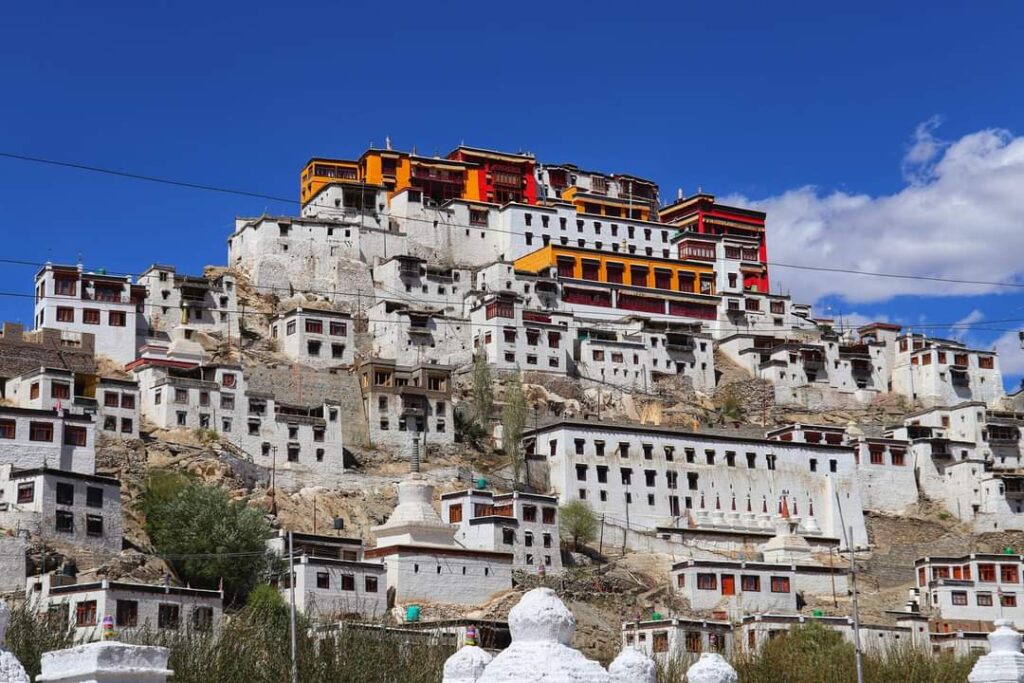
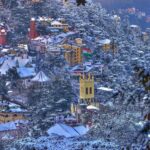
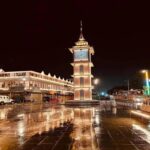
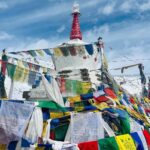

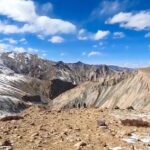
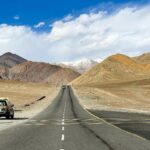
Amazing content 🎆
Love you bro 💖
May Allah bless you 🍀
Thanks for giving this amazing content.
This is really helpful me for my ladakh trip.
🥰😍💜🖤